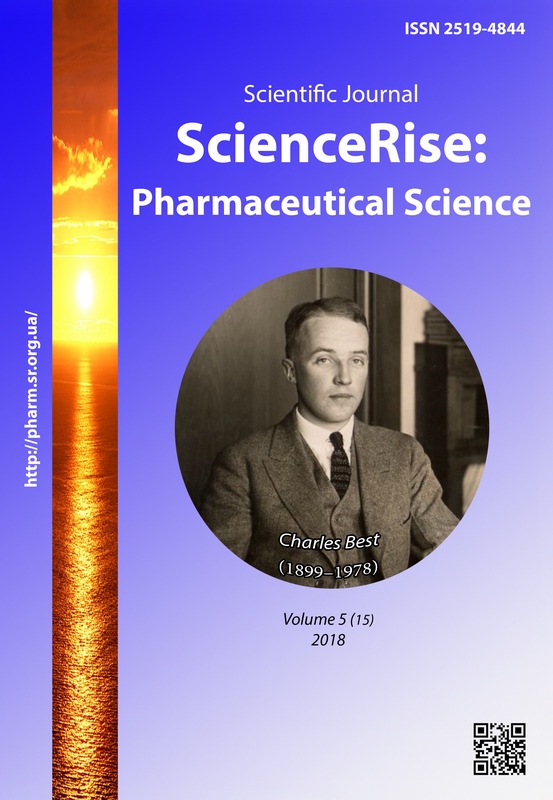Determination of the content of amino acids in the roots of the sophora flavescens
DOI:
https://doi.org/10.15587/2519-4852.2018.146716Keywords:
shrubby Sophora, roots, amino acid composition, essential amino acids, high performance liquid chromatographyAbstract
Shrubby sophora (Sophora flavescens L.) genus of the Fabaceae family is a perennial plant that is common in Russia, Japan, Korea, Northeast, North and Central China. The roots of this plant contain 1-2 % of alkaloids (allomatrin, anagirin, isomatrin, matrine, sofofarpin, soforamin, soforanol), triterpene saponins (soyasaponin I), flavonoids (soforaflavosides I, II, III, IV, biosanin A, kuraridin, kurarin, Cushenols A, B, C, D, I, K, L, M, (-) - maakianin, neokurarinol, norkurarinone) and amino acids (proline, aspartic acid, glycine, argenine). Plant amino acids form a large group of organic compounds and have unique biological and pharmacological properties. Therefore, in recent years, scientists have paid great attention to the study of the amino acid composition of medicinal plants.
The aim of our work was to determine the content of amino acids in the roots of shrubby Sophora (Sophora flavescens L.).
Materials and methods: the study was performed by high performance liquid chromatography (HPLC). Identification of amino acids was performed by comparing the retention time with a mixture of amino acid standards (Agilent 5061-3334). The content of bound amino acids was determined by the difference between the content of free amino acids and their total content.
Results and discussion: as a result of the study, the content of 15 amino acids was found and determined in the free and bound state of shrubby Sophora roots, of which 6 are irreplaceable (threonine, valine, methionine, leucine, isoleucine, phenylalanine).
In a free state, proline (3.61 µg / mg) and aspartic acid (0.73 µg / mg) in the bound state - glycine (1.25 µg / mg), arginine (0.87 µg / mg) accumulated in large quantities, serine (0.84 µg / mg) and glutamic acid (0.80 µg / mg).
In the free state, in the minimal quantities were accumulated methionine (0.024 μg / mg), glycine (0.040 μg / mg) and threonine (0.046 μg / mg), in the bound state - proline (0.079 μg / mg), aspartic acid (0.229 μg / mg) and methionine (0.231 µg / mg). An amino acid such as lysine was not found in the roots of shrubby Sophora.
Conclusions: using the HPLC method, we determined the content of 15 free and bound amino acids in the roots of shrubby Sophora, of which 6 are irreplaceable. Monoaminomonocarboxy, monoaminodicarboxy, diaminomonocarboxylic, aromatic and heterocyclic amino acids were found in the series of bound acids. Considering that amino acids contribute to the rapid absorption and potentiation of the action of other biologically active substances (phenolic compounds, polysaccharides, organic acids, macro- and microelements) contained in plant raw materials, the study of the amino acids of the roots of Sophora flavescens L. is promising for use in official medicine and gives the opportunity to create new drugs of combined action based on the specified type of medicinal plant materials
References
- Shumova, H. S., Vladymyrova, I. M., Nizhenkovska, I. V., Kichapina, T. V. (2018). Perspektyvy zastosuvannia sofory zhovtiuchoi u medytsyni ta farmatsiyi. Materialy naukovo-praktychnoi konferentsiyi z mizhnarodnoiu uchastiu «Aktualni pytannia narodnoi i netradytsiinoi medytsyny v kompleksniyi terapiyi». Kyiv.
- Sandanov, D. V., Shobolova, A. B. (2011). Farmakologicheskie svoystva Sophora flavescens Soland. i ee primenenie v narodnoy i tradicionnoy medicine. Byulleten' VSNC SO RAMN, 1 (77), 268–270.
- Syrovaya, A. O., Shapoval, L. G., Makarov, V. A., Petyunina, V. N., Graboveckaya, E. R., Andreeva, S. V. et. al. (2014). Aminokisloty glazami himikov, farmacevtov, biologov. Vol. 1. Kharkiv: Shchedra sadiba plyus, 228.
- Lee, H., Lee, S., Jang, D., Chung, S.-Y., Shim, I. (2017). Sedative Effect of Sophora flavescens and Matrine. Biomolecules & Therapeutics, 25 (4), 390–395. doi: https://doi.org/10.4062/biomolther.2016.156
- Nagai, N. (1889). Study on Sophora flavescens. Yakugaku Zasshi, 84, 54–87.
- Olennikov, D. N., Sandalov, D. V. (2010). Fenol'nye soedineniya Sophorae flavescens (Fabaceae). Komponentnyy sostav i biologicheskaya aktivnost' (obzor literatury). Rastitel'nye resursy, 46 (2), 126–159.
- Olennikov, D. N., Sandalov, D. V. (2010). Spektrofotometricheskiy metod opredeleniya summarnogo soderzhaniya flavonoidnyh soedineniy v podzemnyh organah Sophorae flavescens (Fabaceae). Rastitel'nye resursy, 46 (3), 131–138.
- Samoryadova, A. B. (2015). Ispol'zovanie fiziko-himicheskih metodov dlya opredeleniya soderzhaniya flavonoidov v sofore zhelteyushchey (Sophora flavescens) kornyah. Farmaciya i farmakologiya, 1 (8), 43–45.
- Ganzul, G., Byambasuren, M., Sukhdolgor, J. (2018). A study of biochemical composition on Sophora flavescens Soland. International journal of research – Granthaalayah, 6 (1), 480–483. doi: http://doi.org/10.5281/zenodo.1172284
- Liu, G., Dong, J., Wang, H., Hashi, Y., Chen, S. (2011). Characterization of alkaloids in Sophora flavescens Ait. by high-performance liquid chromatography–electrospray ionization tandem mass spectrometry. Journal of Pharmaceutical and Biomedical Analysis, 54 (5), 1065–1072. doi: https://doi.org/10.1016/j.jpba.2010.12.024
- Jianhua, Z. Determination of the Contents of Free Amino Acids in Sophora alopecuroides Linn. Available at: http://en.cnki.com.cn/Article_en/CJFDTOTAL-AJSH704.010.htm
- Henderson, J. W., Ricker, R. D., Bidlingmeyer, B. A., Woodward, C. (1999). Rapid, Accurate, Sensitive, and Reproducible HPLC Analysis of Amino Acids. Amino Acid Analysis Using Zorbax Eclipse-AAA Columns and the Agilent 1100 HPLC. Agilent Technical Note, 5980–1193E. Available at: https://www.agilent.com/cs/library/chromatograms/59801193.pdf
- Jámbor, A., Molnár-Perl, I. (2009). Quantitation of amino acids in plasma by high performance liquid chromatography: Simultaneous deproteinization and derivatization with 9-fluorenylmethyloxycarbonyl chloride. Journal of Chromatography A, 1216 (34), 6218–6223. doi: https://doi.org/10.1016/j.chroma.2009.06.083
- Jámbor, A., Molnár-Perl, I. (2009). Amino acid analysis by high-performance liquid chromatography after derivatization with 9-fluorenylmethyloxycarbonyl chloride. Journal of Chromatography A, 1216 (15), 3064–3077. doi: https://doi.org/10.1016/j.chroma.2009.01.068
- Wu, G. (2009). Amino acids: metabolism, functions, and nutrition. Amino Acids, 37 (1), 1–17. doi: https://doi.org/10.1007/s00726-009-0269-0
Downloads
Published
How to Cite
Issue
Section
License
Copyright (c) 2018 Ganna Shumova, Irina Nizhenkovska, Inna Vladymyrova

This work is licensed under a Creative Commons Attribution 4.0 International License.
Our journal abides by the Creative Commons CC BY copyright rights and permissions for open access journals.








